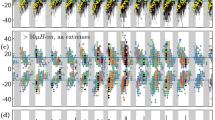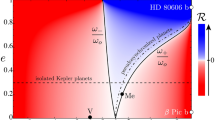Abstract
THE Lyrid meteors excite an interest that might be regarded as quite disproportionate to. their numerical importance. They are a very rare shower, and even when considered by experienced observers as unusually abundant; they seldom appear at a higher rate than about twenty per hour. During the past century the Lyrids liave been subjected to pretty close observation. The star shower seen in America on the morning of April 20, 1803—just 100 years ago—seems to have far excelled in brilliancy its Lyrid successors, though a display witnessed, it is supposed, in 1860 in the equatorial regions, of Africa is described as having rivalled in splendour the November meteor-shower of 1866. Shooting stars were seen in unusual numbers in America on April 20, 1838, and Prof. Forshey observed a Lyrid display in Louisiana on the night of April 18, 1841, when he counted sixty meteors in 2½ hours, which gives a mean rate of twenty-four per hour for one observer. On the morning of April 21, 1863, these meteors were reckoned by an English observer as appearing at the rate of forty per hour. On the night of April 18, 1876, a party of American students casually noticed that shooting stars were unusually numerous during the hours 10 to 12. Lyrid meteors were also conspicuous on the night of April 20, 1874. Mr. Denning has recorded important appearances of Lyrid meteors in 1882 and 1884, especially in the latter year on the night of April 19. The same observer has also stated that the Lyrid radiant was unusually active in 1893 and 1901, in the former on the nights of April 20 and 21, and in the latter on that of April 21. The foregoing are the most important displays on record since April 20, 1803. Periods of somewhat different lengths have been proposed with respect to the Lyrid showers, but the true period seems to be one which overlaps, and consists of nineteen years. Thus, from 1803 to 1860, we have exactly three periods of nineteen years, and from 1803 to 1841, two periods of the same length. Again, thirty-eight years, or twice nineteen years, separate the showers of 1838 and 1876. The nineteen-year period also connects the displays of 1863 and 1882, of 1874 and 1893, and of 1882 and 1901. This nineteen-year cycle is specially interesting, as it is completed at the Lyrid epoch of the present year, reckoning from the somewhat important display of April 19, 1884. A calculation made by the writer indicates that the maximum in 1903 is on April 19, 10h. 30m. G.M.T. The Lyrid radiant ought therefore to be found active in the early part of the night of April 19, probably from the hours 9 to 12. There is no prospect of Lyrids being numerous on the nights of April 20 and 21.
This is a preview of subscription content, access via your institution
Access options
Subscribe to this journal
Receive 51 print issues and online access
$199.00 per year
only $3.90 per issue
Buy this article
- Purchase on Springer Link
- Instant access to full article PDF
Prices may be subject to local taxes which are calculated during checkout
Similar content being viewed by others
Rights and permissions
About this article
Cite this article
HENRY, J. The Lyrid Meteors . Nature 67, 584–585 (1903). https://doi.org/10.1038/067584b0
Issue Date:
DOI: https://doi.org/10.1038/067584b0
Comments
By submitting a comment you agree to abide by our Terms and Community Guidelines. If you find something abusive or that does not comply with our terms or guidelines please flag it as inappropriate.



